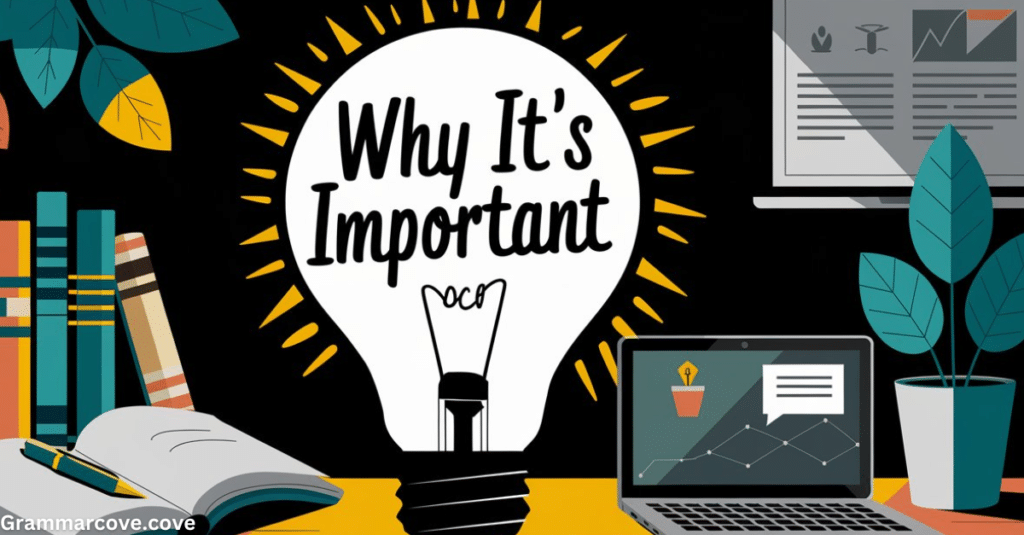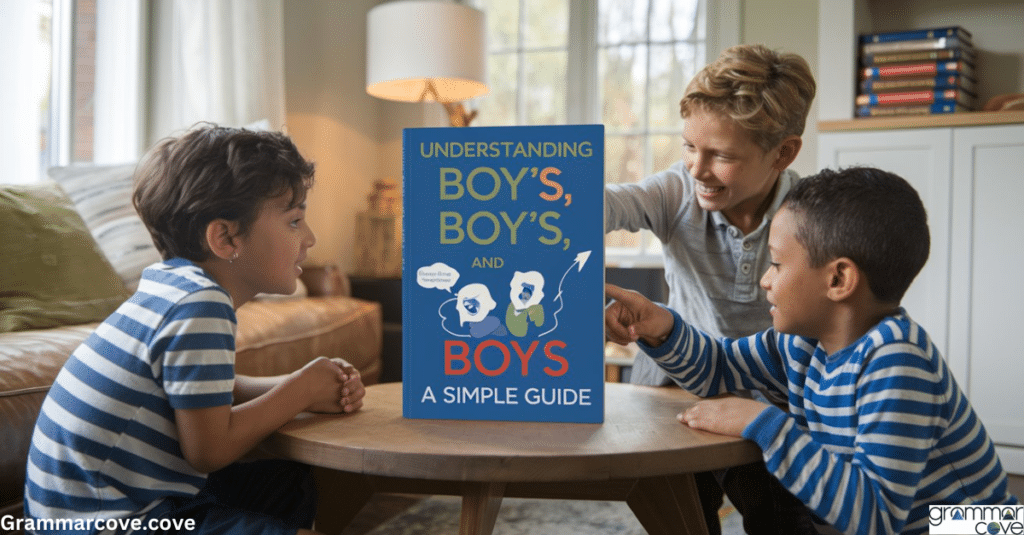Understanding the nuances of English can sometimes feel like solving a puzzle. Among the many pieces, the terms boy’s, boys’, and boys often trip up learners. This guide aims to clarify these differences, providing you with examples and practical tips to enhance your English skills. Let’s dive in!
Boy’s (Singular Possessive)
The term boy’s is a singular possessive form. It indicates that something belongs to one boy. Possessive forms are crucial in conveying relationships and ownership in writing, enhancing writing clarity.
Example 1: Email Scenario
Imagine you are sending an email to a teacher regarding a student’s progress. Here’s how you might phrase it:
Subject: Project Update
Hi Ms. Smith,
I wanted to inform you that Ethan’s science project is coming along nicely. He has gathered all the necessary materials and is eager to present his findings next week. Thank you for your support!
Best regards,
Laura
In this example, Ethan’s clearly indicates that the project belongs to Ethan, demonstrating the singular possessive use of the term.

Example 2: Everyday Conversation
Consider a conversation among friends discussing a recent event:
“Did you see Oliver’s new skateboard? It’s really impressive!”
Here, Oliver’s shows that the skateboard belongs to Oliver. This context reinforces how we use the singular possessive form in daily interactions.

Why This Matters
Understanding boy’s is essential not just for grammar’s sake but for effective communication. When you specify that something belongs to someone, it eliminates ambiguity. This clarity is vital in both writing and speaking, particularly in formal contexts.
Boys’ (Plural Possessive)
In contrast to boy’s, the term refers to something that belongs to multiple boy. This plural possessive form is used to indicate ownership by a group.
Example 1: Email Scenario
Let’s say you are organizing a team event for a group of students. You might write:
Subject: Team Event Reminder
Hi everyone,
Just a quick reminder that the boys’ soccer gear needs to be collected by tomorrow. Please ensure that each player brings their items so we can be prepared for the game. Looking forward to seeing you all there!
Cheers,
Kevin
In this email, specifies that the gear belongs to multiple boy, which is crucial for conveying the correct information.
Example 2: Everyday Conversation
At a school event, a parent might comment:
“The boys’ basketball team played exceptionally well last night. They won by ten points!”
Here, shows that the team, consisting of multiple boy, is collectively recognized for their achievement.

Why It’s Important
Using correctly helps to convey a sense of community or group possession. When discussing shared belongings or achievements, this term clarifies who is involved, which is especially relevant in team settings, classrooms, and social gatherings.
Boys (Plural)
Finally, the term refers simply to more than one boy without any implication of possession. It serves as a straightforward plural form.
Example 1: Email Scenario
Consider this email sent to a friend discussing a recent outing:
Subject: Fun at the Park
Hi Sarah,
Last weekend, the boys had a blast at the park! They played soccer, flew kites, and enjoyed some ice cream afterward. It was a great day!
Talk to you soon,
Jake
In this context, indicates a group of boys enjoying their time together, without any ownership implied.
Example 2: Everyday Conversation
During a family gathering, you might overhear:
“The boys are outside playing catch. They seem really energetic!”
This use of simply highlights a group of boys engaged in an activity, without indicating any possession.
Why Understanding Plural is Essential
Recognizing the term boy is important for Confusing Singular and Plural. It helps paint a clear picture of the situation without complicating the meaning. Whether you’re describing a group in a narrative or talking about a sports team, this clarity enhances the flow of your conversation.
Understanding the Differences: A Table
To visually summarize these concepts, here’s a helpful table:
| Term | Type | Possession | Example |
|---|---|---|---|
| Boy’s | Singular Possessive | One boy | “This is Ethan’s book.” |
| Boys’ | Plural Possessive | Multiple boys | “This is the boys’ locker.” |
| Boys | Plural | None | “The boys are playing soccer.” |
This table serves as a quick reference guide, making it easier to differentiate between these terms at a glance.
Tips for Remembering
1. Visualize Possession
One effective strategy is to visualize possession. For boy’s, picture a single boy holding an item, like Jason’s baseball glove. Imagine multiple boy sharing something, like ’ bikes parked outside. This mental image helps reinforce the concept of singular versus plural possession.
2. Practice with Sentences
To solidify your understanding, practice writing sentences using each form. For example:
- Boy’s: “This is Liam’s backpack.”
- Boys’: “These are the boys’ baseball cards.”
- Boys: “The boy are going to the movies.”
The more you write, the more natural it will feel.
3. Create Mnemonics
Use catchy phrases or acronyms to trigger your memory. For example, think, “One boy = boy’s” (one possessive) and “Many boy = boy’” (plural possessive). Such mnemonic devices can simplify complex concepts.
4. Use Real-Life Examples
Incorporate these terms into your daily conversations or writing exercises. For instance, when talking about your children, say, “My boylove playing outside,” or “This is my son’s favorite toy.” The more you use these forms, the more intuitive they become.
5. Read Aloud
Reading aloud can reinforce your understanding of these terms. As you read books or articles, pay attention to how authors use boy’s, boys’, and boys. This practice not only helps you recognize the terms but also improves your overall fluency.
6. Engage in Language Learning
Participate in language learning activities, like joining a writing group or language exchange. Discussing these terms with others will deepen your understanding and help clarify any doubts. Engaging with peers can also provide practical examples and scenarios.
Common Mistakes to Avoid
Even seasoned English speakers can mix up these terms. Here are a few common pitfalls:
- Confusing Singular and Plural: Ensure you don’t confuse boy’s and boys’. Remember, boy’s refers to one boy, while refers to multiple .
- Misusing Apostrophes: Apostrophes are critical in showing possession. Avoid leaving them out, as in “boys locker” instead of “ locker,” which can lead to confusion.
- Overusing Possessives: While possessives are essential, overusing them can make sentences cumbersome. For clarity, sometimes it’s better to use a simple noun phrase. For instance, say “the toys” instead of “the toys belonging to the boy.”
Practical Exercises
To reinforce your understanding, here are some exercises you can try:
Exercise 1: Fill in the Blanks
Complete the sentences using boy’s, boys’, or boys:
- This is __________ book.
- The __________ basketball team won the championship.
- The __________ are going on a field trip.
Exercise 2: Rewrite the Sentences
Transform these sentences by changing the possessive form where necessary:
- The car belongs to the boy. → The boy’s car.
- The locker belongs to the boys. → The boys’ locker.
- The boy are playing outside. → (No change needed)
Exercise 3: Create Your Own Sentences
Write three sentences using each of the three terms. For example:
- “This is my brother’s favorite game.”
- “The boys’ soccer practice is on Thursday.”
- “The boys enjoy playing video games together.”
Conclusion
Mastering the distinctions between boy’s is crucial for effective communication in English. By understanding these terms, you enhance your grammar rules and improve your overall clarity in writing and speaking. Remember, clarity is key in effective communication, and knowing how to use these possessive forms correctly helps you achieve that.
As you practice, keep the examples and tips in mind. Whether you’re drafting an email, participating in conversations, or writing essays, these concepts will serve you well. The more you engage with these terms, the more naturally they will come to you. Happy learning! If you have more questions about grammar or want to explore further topics, feel free to ask!


